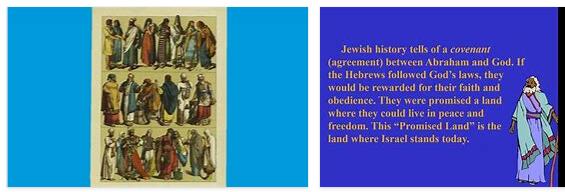
Middle Ages: After the Arab-Islamic conquest, the so-called »Omar Treaty« offered the »book religions« Judaism and Christianity (Ahl al-Kitab) a limited tolerance, which enabled the Jews to largely integrate into the Arab cultural area. This was made easier by the adoption of Arabic (instead of Aramaic, which had been common since the 5th century BC) as the colloquial language. In analogy to the maintenance of the Arabic language, there was also a renaissance of the Hebrew language and the beginnings of Jewish Hebrew studies. The schools of Babylonia shaped the entire diaspora on the basis of the Babylonian Talmud. For two to three centuries, Judaism in the Arab region and Spain dominated culturally, with effects on southern France and Italy.
In the Christian area, the initial situation was more diffuse. From the Roman Empire, the shrinking Byzantium with some Italian territories and to that extent also the old legal status of the Jews was retained despite Christian restrictions. In the other successor realms, this old legal basis was replaced by privileges that were granted to individuals and groups by the respective ruler for economic and fiscal considerations. Around these privileged people, communities with internal autonomy crystallized. The assignment to the Christian ruler could, depending on interests and power situation, mean protection, but also endangerment in conflicts of interest and was always dependent on tensions within the Christian church. Judaism was tolerated as the only minority, but it seemed all the more alien, found himself exposed to increasing hostility and often served as a scapegoat. In Ashkenaz (Central Europe), the core of the early communities consisted of rabbinically learned long-distance traders who also carried out the large-scale money trade. You were through the The persecution of Jews during the Crusades in 1096 and 1147/49 was badly hit and at the time of the plague epidemic of 1348/49 they were again subjected to bloody persecutions. Ousted from long-distance and money trading on a grand scale, excluded from many professions by guilds and bans on land acquisition, retail, pawnbroking and money trading offered only a narrow livelihood for the growing, socially overburdened communities. At the end of the Middle Ages, Jews were gradually expelled from almost all of the more important German cities. Since the 15th century, many emigrated to Eastern Europe (initially mainly to Poland). In the Jewish communities living largely among themselves within the Slavic environment, a culture of their own developed (Yiddish language, Yiddish literature).
In the Mediterranean area, where Judaism was initially largely socially integrated, it developed a broad theological and scientific activity in dealing with Islamic culture. Jewish law was systematized through commentaries on the Talmud and compendia. The commentary on the Talmud by Solomo ben Isaak (called Raschi), the compendia of Isaak ben Jakob Alfasi (North Africa, * 1013, † 1103) and Maimonides as well as of Jakob ben Ascher (Toledo, * 1270 (?), † 1340) were fundamental. The last Codex wrote J. Karo (Shulchan Aruch). The commentaries on the Bible reflect the different orientations in Judaism: In addition to traditional midrash-like works, there are new explanations of words and texts, also specifically linguistic, philosophical or cabalistic.
Since there was no common cultural language in the Christian area (Latin was only the Christian monastery and school language), a discussion of the prevailing culture was less obvious. The Jews used Hebrew; Scientific and philosophical texts often only continued to have an effect in Hebrew translations. Neoplatonic tendencies dominated theologically at first, vulgarized also in popular piety. Aristotelianism and Averroism were reserved for an elite class, which was met with fierce resistance from the traditionalists who dominated Ashkenazi Judaism. The Kabbalah had an integrating effect; despite its Neoplatonic basis, it was articulated using traditional means and was ultimately regarded as the ultimate Jewish tradition. It shaped piety up to the Enlightenment.
Early modern times: The expulsion from Spain (1492) and Portugal (1496) was seen in Judaism as a mark of the era and a sign of the near end. The Ottoman Empire, religiously tolerant and interested in economic development, offered asylum to many emigrants, and so flourishing Sephardic communities (Sefarad) emerged in Greece, Asia Minor and Palestine, which fell into disrepair with the decline of the empire in the 18th century.
In the west (especially in Amsterdam, Hamburg, London and overseas), Sephardic colonies emerged, which played an important role in long-distance trade and like the “court Jews” who were employed by the rulers of Central Europe as advisors on financial and supply issues and were accordingly privileged. anticipated a certain emancipation and secularization. In Eastern Europe, where the Jews had initially received privileges from the Polish king, a heyday in the 16th century followed the Cossack revolts of 1648 and the pseudo-Messianic movement of Sabbatianism (around 1666), which had spread to the entire diaspora, followed by rapid social decline Population growth.
According to definitionexplorer.com, Eastern Jewry emerged from the Ashkenazim in the 18th century, with its long history of shaping the image of Judaism – which was also negative in Western Europe: strict piety, extensive isolation from the influences of modernity, traditionally determined clothing and hairstyle, life in the Stetl. The social and spiritual-religious crisis promoted the spread of mystical Hasidism which, as a popular movement, was initially in sharp opposition to the orthodoxy of the rabbinical scholar class. In the west, too, the communities were powerless to face growing poverty and social problems. The enlightened absolutism and Jewish enlightenmentists therefore strived for “improvement” of the Jews in the sense of social and fiscal benefit with correspondingly greater rights.